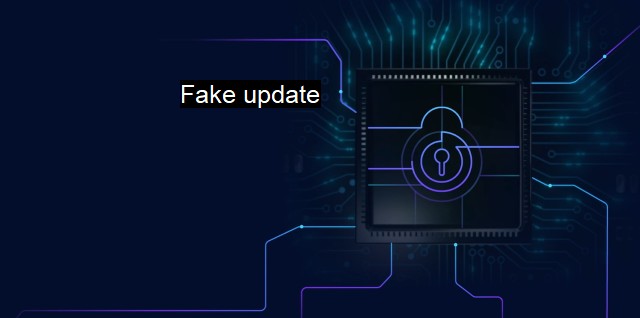What is Fake update?
Unveiling the Menace of "Fake Updates": An Examination of Deceptive Software Notifications and Its Malicious Intentions
In the sprawling discipline of cybersecurity, a "fake update" is a widely used villainous technique that has been utilized by hackers for infiltrating and compromising computing systems. Primarily aimed at duping and exploiting unsuspecting users, a fake update sneaks into computer systems under the guise of being a legitimate software update, but instead contains malicious software, or malware — a harmful piece of code created to perform unwanted or damaging operations on the target victims’ systems. users are baited to download and install these fake updates, thus inadvertently granting hackers entry into their computing environment.Ranging from ransomware, spyware, trojans to keyloggers and more, the malware delivered via fake updates is designed to steal valuable information, monitor user's activities secretly, or seize control of a system outright. Consequently, the data to be stolen may cover a broad swath from financial credentials, personal data, corporate secrets, all the way to launching cyberattacks that could further compromise or entirely bring down a network.
Fake updates primarily ride on the precarious human factor by carefully manipulating human emotions like curiosity, anxiety, or fear. To do so, they deploy meticulously crafted social engineering tactics employing misleading information to guide users into surrendering sensitive details or to initiate actions that pave the way for infiltration. For instance, some cybercriminals masquerade these fictitious updates as urgent, bearing alarming messages about a network's security status and the need to promptly patch some perceived vulnerabilities, urging unsuspecting users to act immediately.
The modus operandi often involves a great level of camouflage to deceive the discerning eye. Commonly, web browsers are a prime channel for the delivery of such fake updates. Attackers construct pop-up windows, which resemble alerts from the victim's operating system or an application they are running visually. They artfully craft the design, content, and language, paralleling that of authentic software vendor’s, matching logos, color schemes, and fonts to imitate trust and authenticity.
In other instances, fake updates can come as embedded links or attachments in email or instant messages, cleverly disguised as urgent security updates, newly released features, theme extensions, or user-friendly tool enhancements. Threat actors can leverage legitimate website vulnerabilities to inject exploitable scripts that trigger fake update prompts, or they may even go as far as recreating replicate websites of reputable providers, eliciting users to download from sites they deem trusted.
Even though fake updates prove to be a significant threat several powerful antivirus programs help provide robust defense mechanisms. They routinely scan and check for definitions of known malware in downloaded files and obstruct the installation of potentially harmful elements, issuing warning alerts where an anomaly gets detected. Through heuristics and behavioral patterns, Antivirus software could identify and quarantine potentially hazardous files even before an infiltration.
The users should apply a healthy level of skepticism and vigilance while dealing with unexpected or unsolicited updates. They should download updates only directly from the software’s official websites or trusted sources, avoiding inadvertent triggering of malicious downloads. Proactive measures, such as securing their systems with updated antivirus software, routinely installing security patches, and adopting safe browsing habits all prove beneficial across the board.
Fake update is a formidable weapon for cybercriminals, deployed primarily as malware payloads to further their malicious intent — from espionage, data theft, to wreaking havoc on systems and networks. The principle of the trust-but-verify model holds the best defense ante, coupled with advanced antivirus software and cybersecurity tools, to maintain a sturdy line of defense against such threats. If we separate the ostensible urgency of some situation from the necessity of rational cautious steps, it becomes amazingly simple to contend with and conquer the looming menace of these fake updates.

Fake update FAQs
What is a fake update?
In the context of cybersecurity and antivirus protection, a fake update is a type of malware that disguises itself as a legitimate software update. Its goal is to trick the user into downloading and installing the malware onto their device.How can I identify a fake update?
Fake updates often have subtle differences from authentic updates; for example, typos or misspellings in the name or description of the update, or a slightly different logo or color scheme. Always verify the authenticity of any update before downloading and installing it.How can I protect myself from fake updates?
The best way to protect yourself from fake updates is to only download updates from official sources, such as the official website of the software provider or through the software itself. Avoid downloading updates from third-party websites or pop-up messages that appear on your screen. Additionally, keeping your antivirus software up-to-date can help safeguard against fake updates.What should I do if I suspect a fake update?
If you suspect that an update is fake or malicious, do not download or install it. Instead, run a virus scan on your device using your antivirus software. You can also report the fake update to the software provider or to cybersecurity experts for further investigation.| | A | | | B | | | C | | | D | | | E | | | F | | | G | | | H | | | I | | | J | | | K | | | L | | | M | |
| | N | | | O | | | P | | | Q | | | R | | | S | | | T | | | U | | | V | | | W | | | X | | | Y | | | Z | |
| | 1 | | | 2 | | | 3 | | | 4 | | | 7 | | | 8 | | |||||||